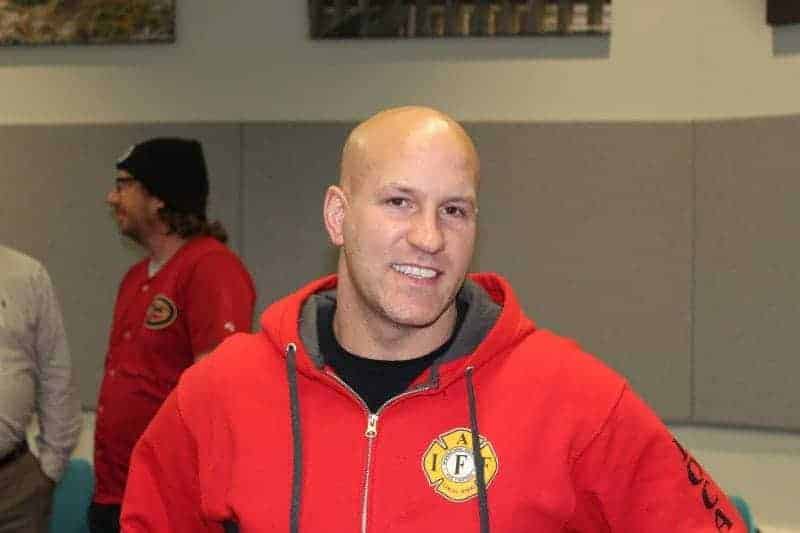The city is set to get four new firefighters, even though these hires weren't originally in the 2018 draft budget.

Jamie Stringer, vice-president of the Yellowknife Firefighters Association, was joyful after council decided to expidite the hiring of four new firefighters. “It was very exciting, an unexpected outcome to be honest,” he said Wednesday.
Dec. 5, 2017
Council unanimously decided to add $93,000 to the proposed budget to pay for four firefighters, who will start work in October.
Many cuts and additions to the budget draft were made over three nights of public deliberations this week. A final version of the budget will be adopted by council Monday.
More than a dozen firefighters decked out in union gear sat through some 12 hours of lengthy budget talks – a clear statement of their demand for more staff.
“The proceedings were a real nail-biter, but we're so happy,” Jamie Stringer, vice-president of the Yellowknife Firefighters Association, said after deliberations wrapped up Wednesday.
“A lot of these guys have been working ... for the last 24 hours,” said Stringer, praising his colleagues' stamina and determination during a week that saw the Yellowknife area hit with three separate fires.
Yellowknife currently employs 28 full-time firefighters.
A 2016 Fire Division Master Plan, drafted by a Calgary-based consulting firm, found Yellowknife's fire department to be understaffed and recommended that the city hire eight new firefighters.
Four firefighters were brought on this year, at a cost of $222,000 for salaries, gear and lockers.
Hiring the remaining four had initially been deferred to January 2019.
On Wednesday, council decided not to wait another full year to staff up the fire department, which handles both fire and medical responses.
“I don't think most families in this city would sleep well at night knowing that we're only somewhat understaffed now, in terms of our emergency first responders,” Coun. Shauna Morgan said Wednesday night.
The city had hoped the safe ride van, which transports people in need to shelters, would result in a drop in calls for fire and ambulance assistance – as it has for police responses – but that hasn't yet borne out.
Fire and ambulance calls have actually gone up, said Morgan.
She said the call volume from January to September of 2017 is 22-per-cent more than the average call volume over that period for the previous five years.
The average number of calls during those months from 2012 to 2016 was 2,798, said Morgan, and this year it's 3,426.
The strain on firefighters and paramedics is “high or higher than ever,” said Morgan.
She went on to say that Yellowknife requires a minimum of five people at the fire hall at any given time, meaning that if there's an incident that calls for a two-vehicle response, and a medical call comes in, there isn't the capacity to send an ambulance right away.
“To me that's not acceptable, that's high-risk,” said Morgan.
Director of public safety Dennis Marchiori said medical calls get priority.
There was much talk during this year's budget deliberations about the value of hiring new full-time staff.
This came after the city proposed adding 3.61 full-time equivalents (not including the four new firefighters) to its current payroll of 222.7.
Sheila Bassi-Kellett, the city's senior administrative officer, said there is “urgency” to fully staffing the fire department
“In any area of the city where we have so many projects underway, we know that new staff, that a full staff compliment makes a huge difference when it comes to being able to do the job,” she said.
Bassi-Kellett said the initial idea to delay adding new firefighters was in response to fiscal pressures on the city and involved a “really horrible discussion.”
The city is hopeful that over time the safe ride van will result in a decrease in calls to fire and ambulance.
For the last three years, the city has spent around $200,000 annually on firefighters' overtime pay.
Overtime costs at the fire department can't be avoided, states the fire master plan.
When a report comes in of a major fire (“flames and smoke from a structure,” said Marchiori), all firefighters are called, not just those at the fire hall.
“Really, our overtime is only going to go up if we have more people,” said Coun. Niels Konge.
While he supported hiring new firefighters, Konge suggested the fire department change its all-hands-on-deck protocol to cut overtime costs.
Bassi-Kellett said its not a “free for all” when a call goes out to all the firefighters.
“Often people are not available, so when a call goes, not everybody shows up to respond,” she said.
On Thursday, Coun. Julian Morse said council managed to cut about $700,000 from the budget draft, and whittle down the proposed tax hike from 4.32 per cent to 1.8 per cent.
However, cautioned Morse, neither of these figures, along with any cuts and additions to the budget, are certain until council votes on a final draft next week.
Most of the cuts were made to the capital fund, which covers construction projects and physical items in the city.
Namely, council decided not to extend the Frame Lake Trail, which would have cost around $300,000.
The proposed anti-poverty strategy, which came in at $75,000, also got the axe.
Morse said this year's cuts weren't as dramatic as those made to previous budgets.
“There's been years where we've cut millions from capital,” he said.
Morse said the marathon of budget talks yielded wins and losses for every councillor.
“I believe pretty strongly in our process and I believe strongly in the democratic process,” he said.
“It's not over until the fat lady sings, as they say.
“Definitely Monday will be interesting.”